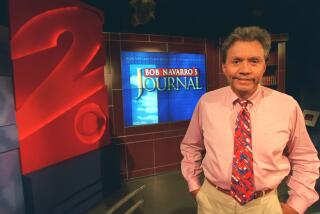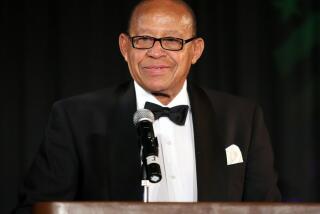Octavio Gomez, 71; Cameraman Helped Cover Latino Civil Rights Movement
Octavio Gomez, a cameraman whose work put him at the center of the region’s Mexican American civil rights movement and placed him by Ruben Salazar’s side when the journalist was killed while covering a riot in 1970, has died. He was 71.
Gomez, one of the first Latinos to work locally as a television cameraman, died of a heart attack Dec. 30 at a friend’s home in Los Angeles, his family said.
“He was a true pioneer of Hispanic media here in Los Angeles,” said Frank Cruz, a former television news anchor and a founder of the Spanish-language network Telemundo. “And he was a gutsy cameraman.”
Felix Gutierrez, a USC journalism professor, called Gomez a “breakthrough journalist” because he succeeded in the print and broadcasting media, “which very few have done.”
Shortly after arriving in Los Angeles in 1969, Gomez became a cameraman at the Spanish-language station KMEX.
Later, he spent several years as a photographer at the Spanish-language newspaper La Opinion and freelanced for many broadcast outlets.
“He would stop at no end to get a story, including flying off to Central America with KMEX-TV camera equipment without getting his bosses’ permission,” Gutierrez recalled.
In 1985, Gomez was awarded $195,000 in damages in a press freedom case that accused immigration authorities of interfering with his ability to take photographs for La Opinion.
The lawsuit centered on two events a week apart -- a protest against refugee deportations and a roundup of illegal aliens -- in which INS agents confiscated Gomez’s camera and press credentials and reportedly made veiled threats about his immigration status.
At the time, Gomez was a Mexican national who had been in the country legally since 1968. He became a naturalized citizen in 1994.
“It wasn’t that trouble followed him, it’s that he was fearless,” said his elder son, Michael, who witnessed the second incident as a 12-year-old riding along with his father in 1981.
“Being an immigrant, he was pretty sympathetic to the cause.”
Colleagues nicknamed the 5-foot-3 photographer Chapo -- Spanish for “shorty” -- partly because the camera equipment he lugged around dwarfed him.
In 1972, Gomez helped resolve the hijacking of a Frontier Airlines plane at Los Angeles International Airport after the hijacker asked to speak with someone from the Spanish-language media.
To his surprise, Gomez knew the hijacker, Ricardo Chavez-Ortiz, with whom he had briefly worked and lived.
Gomez documented the scene as the hijacker’s sole demand -- that his concerns about the plight of Mexican Americans be heard -- was broadcast on radio. Chavez-Ortiz then handed over his empty gun and surrendered.
“Octavio wasn’t afraid of anything,” said Roberto Cruz, the former news director and anchorman at KMEX who hired him. “When there were riots in East L.A., police were throwing tear-gas canisters and one hit him in the chest, but he kept the camera running.”
While covering the 1970 National Chicano Moratorium rally against the Vietnam War that exploded into a riot in East Los Angeles, Gomez and the KMEX news crew stopped inside a bar for a break. A sheriff’s deputy fired a tear-gas canister inside -- striking Salazar, the news director of KMEX and a Times op-ed columnist.
“The bar went dark, and Octavio got out uninjured and couldn’t get back in,” Roberto Cruz recalled. “When Octavio came back to the station, I asked, ‘How about Ruben?’ He said, ‘I think he was hurt. Maybe he’s in the hospital.’ We didn’t know he was already dead.”
Gomez was born Nov. 15, 1934, in Puebla, near Mexico City, one of five children of Raymundo, a railroad conductor, and Eloina, who worked as a haute cuisine cook.
While in the Mexican air force, Gomez discovered photography when his unit took pictures of the island of Cozumel, where they were stationed.
Gomez made his way to Tijuana, where his brother Jorge was a TV cameraman.
He apprenticed with his brother and served as the puppeteer host of a cartoon show.
After meeting Cesar Chavez in 1966, Gomez awoke to the power of politics -- and his camera. For almost 20 years, he documented the United Farm Workers movement, including Chavez’s hunger strikes and the struggles to unionize the grape-growing industry.
He raised his family in Glendale but moved to Los Angeles after he and Cecilia, his wife of 16 years, divorced.
A heart condition led Gomez to retire about eight years ago.
For her college admissions essay, his daughter Gabriella looked to her father to answer the question, “What is the defining moment of someone in your life?”
“From my father, I learned that you can’t let suffering go unnoticed,” his daughter, who became a lobbyist, recalled writing.
“You have to be out there, fighting for the underdog.”
In addition to Gabriella, of Washington, D.C., and Michael, of Long Beach, Gomez is survived by another son, Daniel R. Gomez of Glendale, a brother and a sister.
More to Read
Sign up for Essential California
The most important California stories and recommendations in your inbox every morning.
You may occasionally receive promotional content from the Los Angeles Times.











